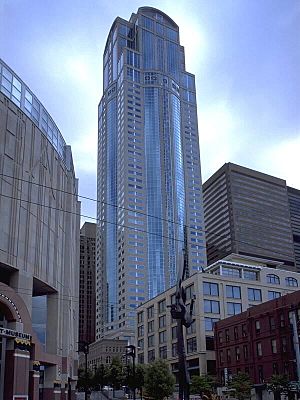Washington Mutual facts for kids
 |
|
| Industry | Finance and Insurance |
|---|---|
| Fate | Insolvency. Closure by the Office of Thrift Supervision. Transferred to the FDIC who then sold WaMu to JPMorgan Chase. |
| Successor | JPMorgan Chase |
| Founded | September 25, 1889 |
| Defunct | September 25, 2008 |
| Headquarters | Seattle, Washington, United States |
|
Key people
|
Alan H. Fishman, Chief Executive Officer |
| Products | Consumer Banking Financial Services |
| Revenue | US$15.962 billion |
|
Number of employees
|
49,403 |
| Subsidiaries | WaMu Investments, Inc; Washington Mutual Insurance Services; Washington Mutual Card Services |
Washington Mutual (often called WaMu) was once the biggest savings and loan association in the United States. A savings and loan association is a type of bank that mainly helps people save money and get loans for homes. Even though its name included "Mutual," it stopped being a mutual company in 1983. This means it started selling shares to the public on the New York Stock Exchange.
On September 25, 2008, which was WaMu's 119th birthday, a government agency called the Office of Thrift Supervision (OTS) took control of the bank. They then sold most of its working parts to JPMorgan Chase. WaMu's shutdown was the largest bank failure in U.S. history. Before it closed, it was the sixth-largest bank in the country. In 2007, WaMu reported that it owned assets worth about $327.9 billion.
Contents
What Was Washington Mutual?
Washington Mutual started a long time ago, in 1889. For many years, it helped people save money and get loans. It grew to be a very large company with many customers.
How WaMu Changed Over Time
At first, WaMu was a "mutual company." This means it was owned by its customers, not by shareholders. But in 1983, it changed. It became a public company, meaning anyone could buy shares of its stock on the stock market. This helped WaMu grow even bigger.
Why Did WaMu Close Down?
In 2008, there was a big financial crisis in the United States. Many banks and financial companies faced serious problems. WaMu had made many loans that people could not pay back. This made the bank lose a lot of money.
The Government Steps In
Because WaMu was losing so much money, the government's Office of Thrift Supervision decided to take action. They took control of WaMu to protect its customers and the financial system. This action is called "seizing" a bank.
Selling WaMu's Assets
After taking control, the government quickly sold most of WaMu's good parts, like its branches and customer accounts, to another large bank called JPMorgan Chase. This happened very fast, in just one day. This sale helped make sure that WaMu's customers could still access their money and services.
What Happened After WaMu Closed?
The closure of WaMu was a huge event. It showed how serious the financial crisis of 2008 was. Even though WaMu itself no longer exists, its former branches and many of its customers became part of JPMorgan Chase.
The Impact of the Closure
The failure of Washington Mutual was the biggest bank failure in U.S. history. It was a big deal because WaMu was such a large bank. The government's quick action helped prevent even bigger problems for the economy.
Images for kids
-
A former WaMu branch in the Chinatown section of New York City (2004)
-
A WaMu office in Naperville, Illinois
-
A WaMu Financial Center in San Jose, California
-
The WaMu Tower (center right) in downtown Seattle was WaMu's corporate headquarters from 1988 until 2006, when the company moved into the new WaMu Center (center left). These buildings have since been renamed; WaMu Tower is now known as 1201 Third Avenue and WaMu Center is now known as Russell Investments Center.
See also
 In Spanish: Washington Mutual para niños
In Spanish: Washington Mutual para niños






